Truda M Straede
First published in 'On the Spot' 108 Mar 2015
Newsletter of the Australian Mist Cat Fanciers Association Inc
| I
started breeding in 1977, but not until the start of 1979 did I
decide that I should become serious about record keeping. For every
litter I have bred since that time, I have kept a litter card,
recording: Sire & Dam: Name, Registration No, Colour,
pattern, breed; any known genetic details: Mating & Birth Date:
Number, Colour and Sex of each kitten: Notes on each kitten including
birth order, weight, deaths, deformities, causes of death, illnesses,
treatments. Through tabulating the information from every card year by year, I have been able to make some interesting observations and summaries. Some of these I share with you here. |
TOTAL
NUMBER OF LITTERS BRED 1979-2014 = 792
BY BREED: BURMESE 52 ABYSSINIAN/SOMALI 64 SIAMESE/BALINESE/ORIENTAL 21 DOMESTIC/X BRED 27 AUSTRALIAN MIST 588 MAINE COON 37 |
|
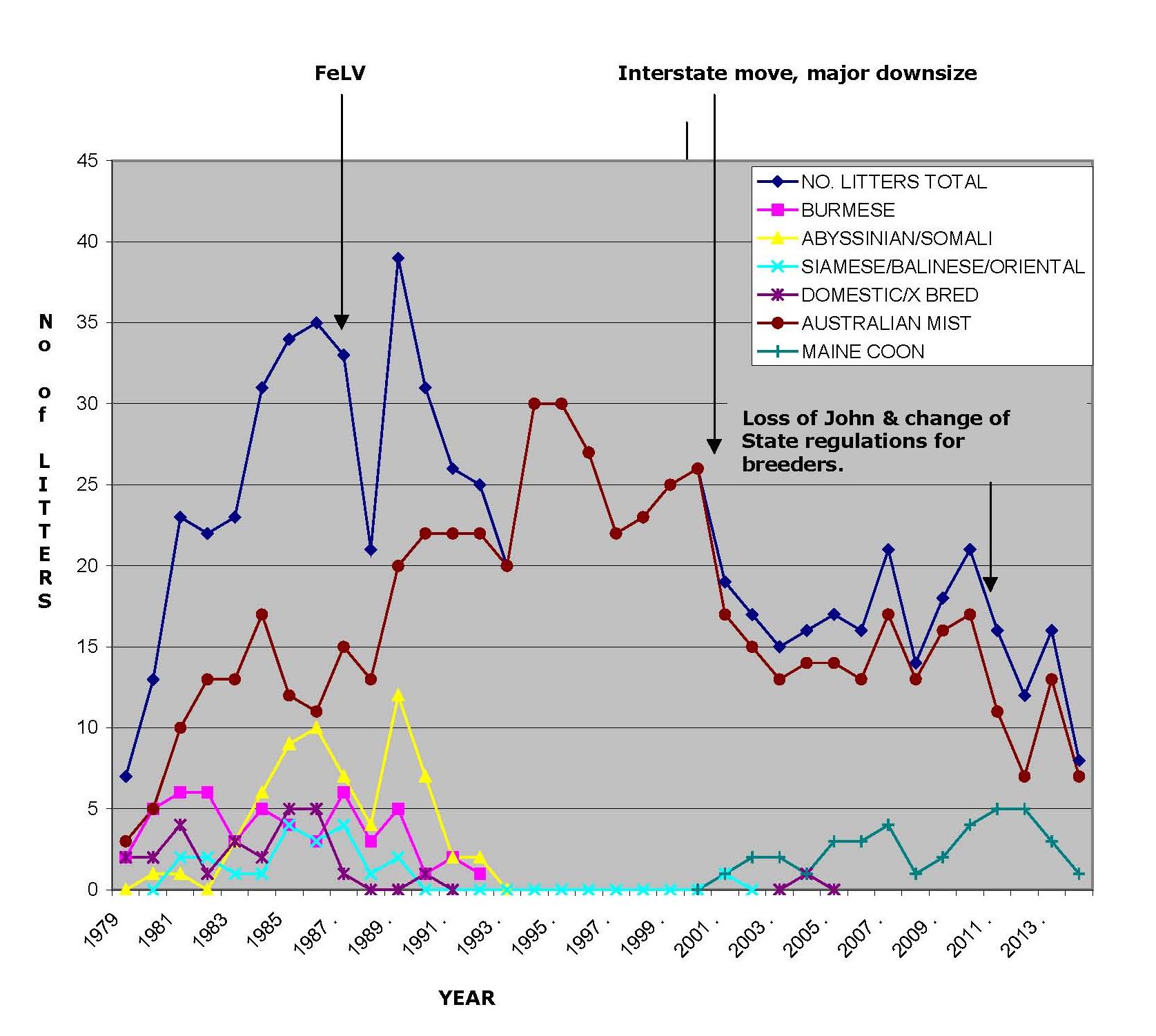 |
||
| The
distribution of these breeds over time reflects my growing
devotion to Australian Mist, and a number of major events in our lives. In 1983, my already growing numbers were boosted when John and Cheryl Straede combined their Burmese and Abyssinian breeding with my Burmese, Siamese and Spotted Mist Foreign Shorthair breeding. We met as ‘Experimental’ breeders – they were working on the Sydney Silvers (later incorporated into Abyssinians as Silver Abyssinians) and I was working on the Spotted Mist Foreign Shorthairs. We competed with each other in a 'New Breeds' section …. The outbreak of Feline Leukaemia in 1987 not only had a direct impact that year, but carried over into 1989 as I replaced older breeding stock with new. After that numbers bounced back and we decided that it was time abandon breeding everything except Australian Mist – at least in the feline area – Cheryl took up breeding Chihuahuas and Papillions …. On the loss of Cheryl in 2000 John and I planned to move interstate, and started serious downsizing, so that when finally I moved the cats in 2001, they totalled just 40, predominantly entire cats. Inevitably the numbers grew again, specially as I was becoming interested in improving my Maine Coons as well as my Australian Mists, and I was busy adding a new blood line to the Mists. John’s illness from 2011, and his death in 2012 motivated me to make a big effort to reduce my feline population, but probably didn’t impact my litter numbers so noticeably, as I largely moved on many retirees and a few entire boys. However, in 2014 new Victorian State regulations governing the breeding of cats came into force, which resulted in my reduction of females to 9 or less – so the litter numbers certainly fell, and will continue to do so as there are also regulations governing other aspects of breeding which will constrain the maximum number of litters I can breed over the coming years. There can be no doubt, however, that this pie diagram shows exactly where my major interest has always lain – 74% of all the litters I have bred have been Australian Mist!! |
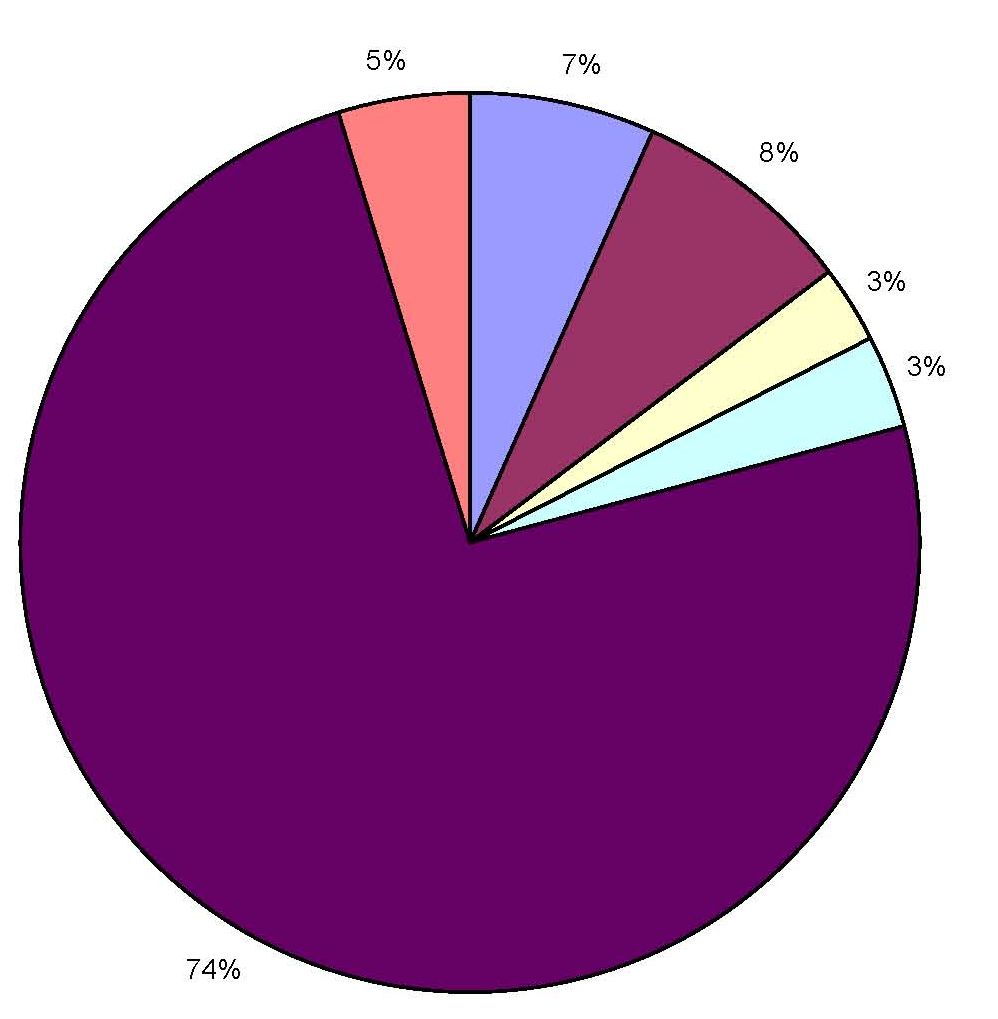 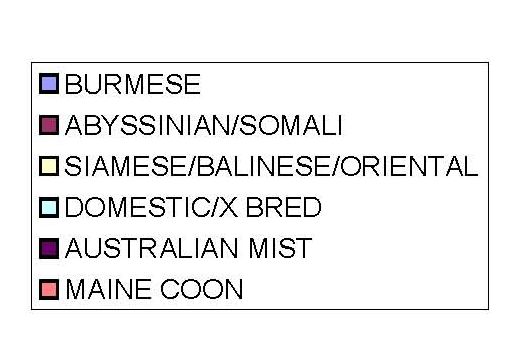 |
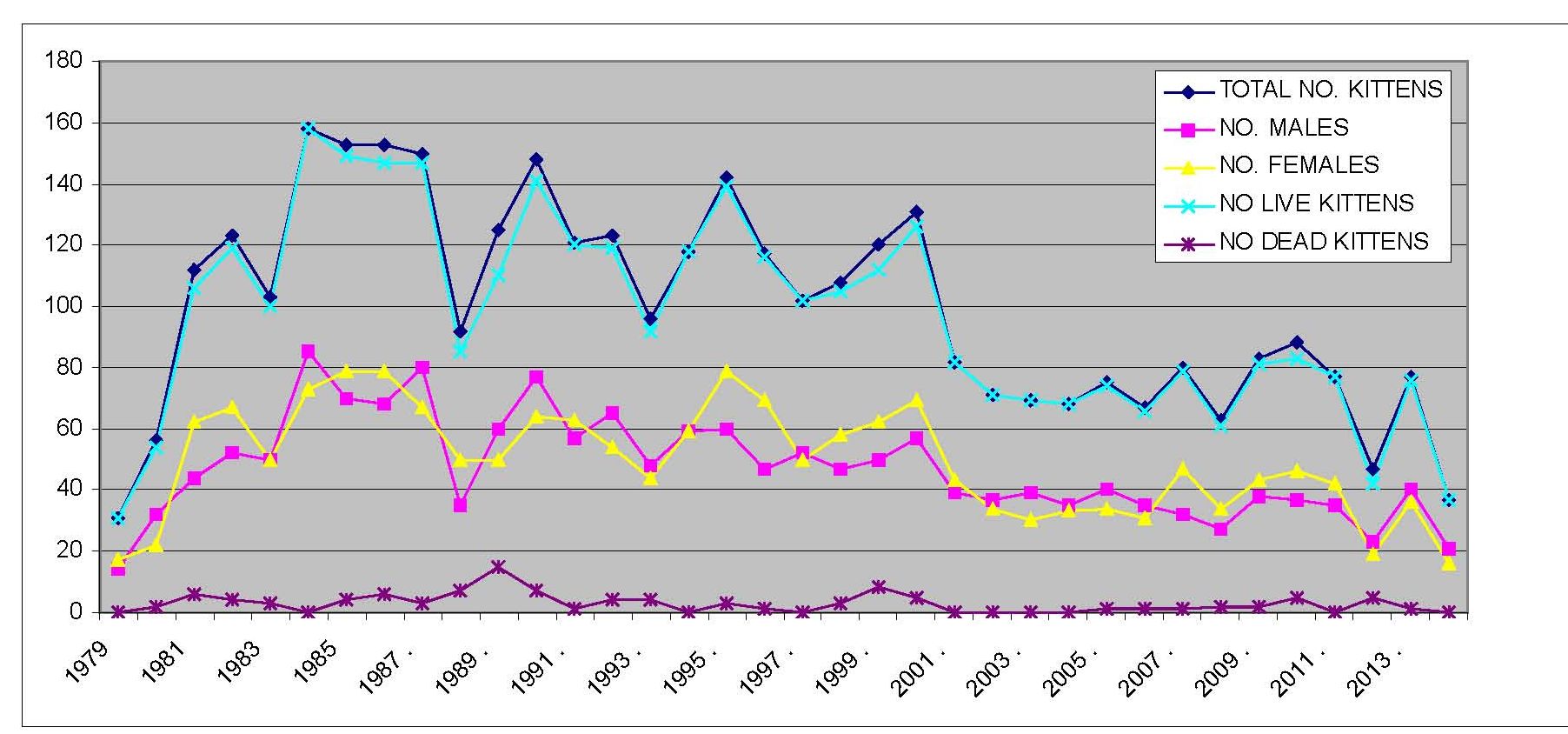 |
|
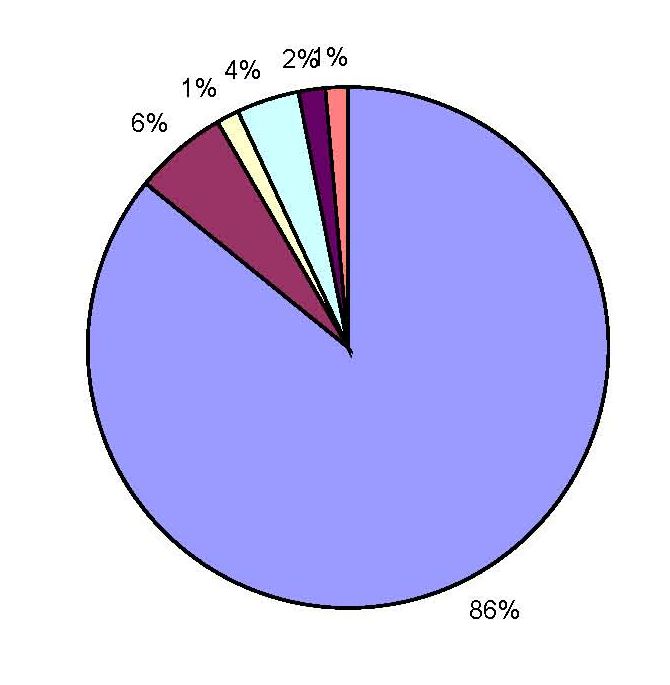  |
The total number of
kittens born follows very much the same
pattern as for the litters, the male to female ratio appears to remain
around about the same, with the number of kittens dead (at birth,
including immature foetuses, embryos and placentas only) remains fairly
consistent. When survival to 12 weeks is considered, the mean survival over the 36 years of record stands at 86%, with the greatest loss component being still birth, which includes all prenatal deaths, including immature foetuses, embryos and placentas. 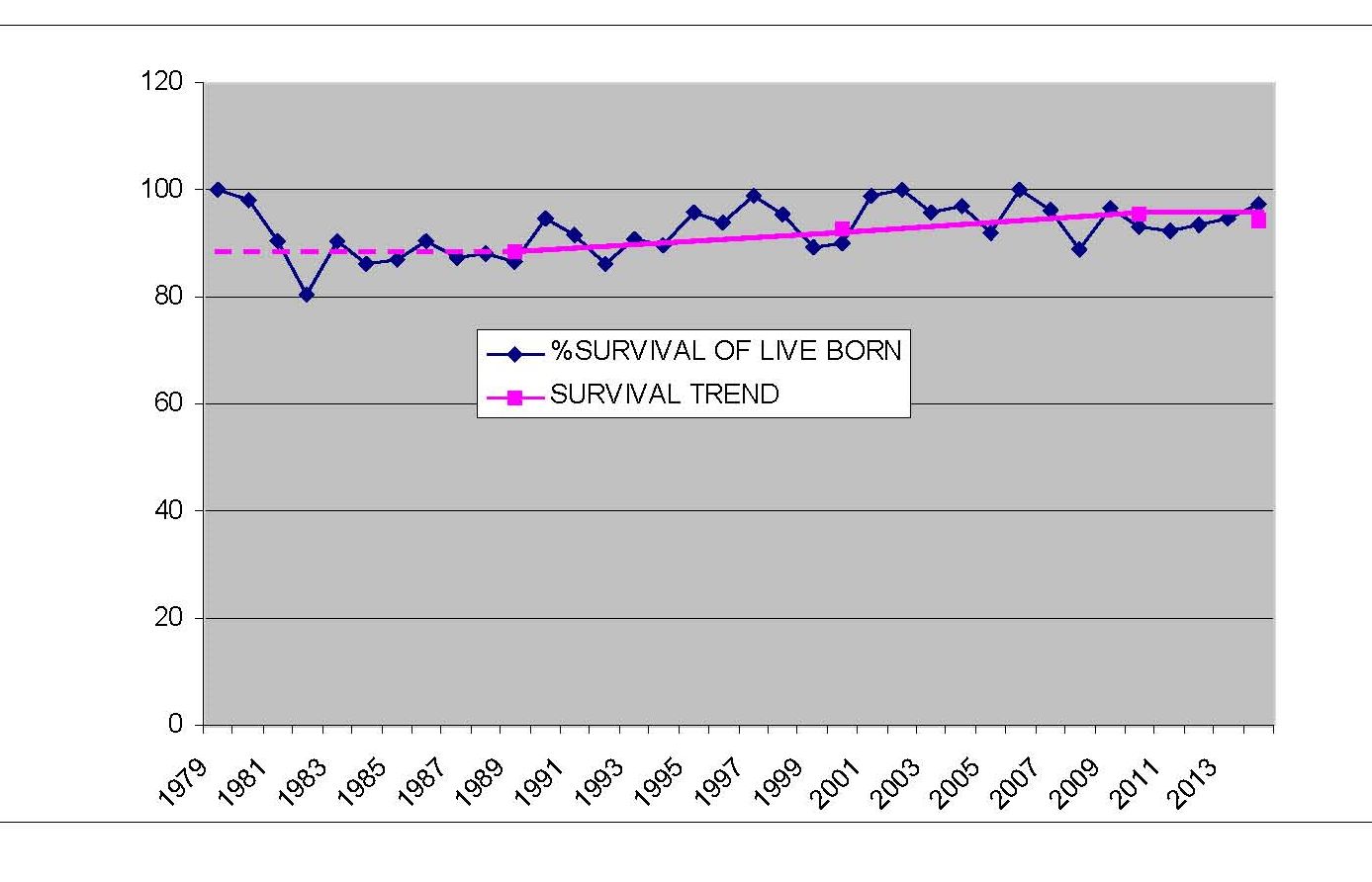 |
| When the long term trend of survival to 12 weeks of kittens born alive is considered, some long term improvement can be discerned, but it never does reach 100%, but levels off at 95%. A 12 week cut off was chosen in that at this age the majority of kittens are dispersed to their new owners, and I neither have control over their care, nor full information about their fate. | |
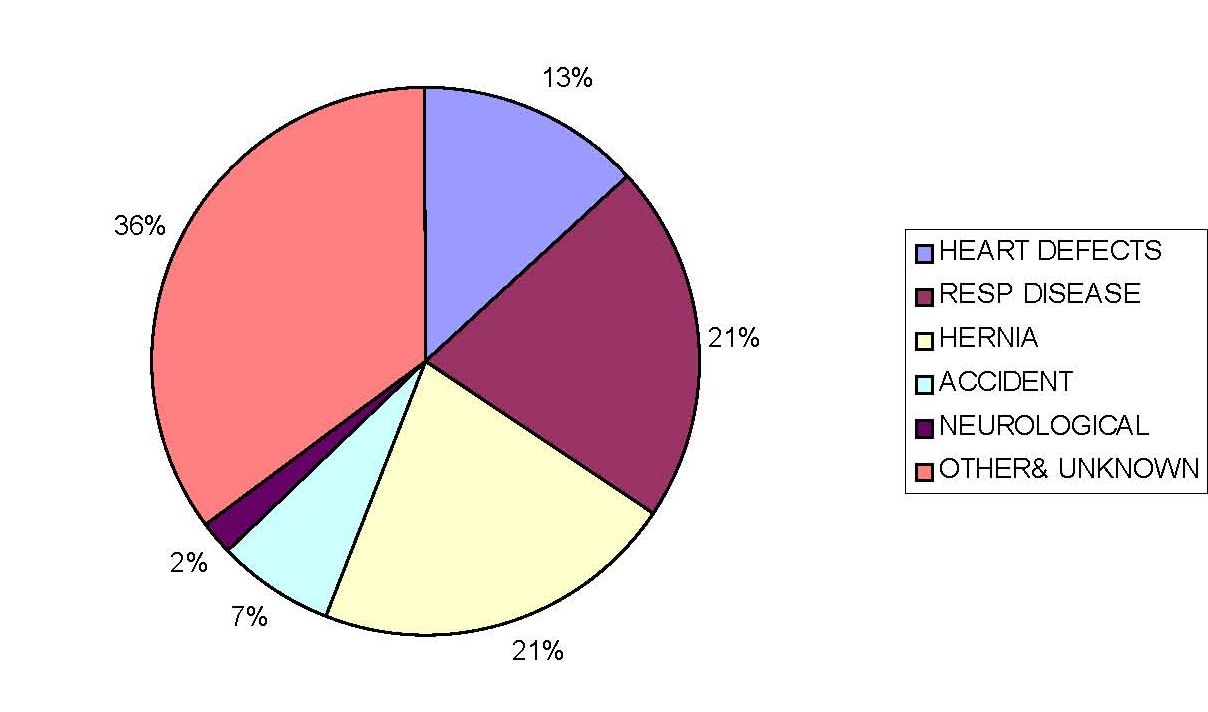
| When the causes of post
natal deaths up to 12 weeks of age are
analysed, more than one third are ‘one off’ causes, or unknown.
Respiratory disease and hernias contribute about one fifth each, with
heart defects just over one in ten. It was of course, not always possible to determine the cause of death, though the hernias recorded are all very large, and obvious, such kittens requiring immediate euthanasia. Heart defects were largely hole in the heart, and a few patent ductus arteriosis. However, it should be borne in mind that these were usually ascertained by me, only occasionally by my vet, and my skills as a Zoology major undoubtedly fell far short of my vet’s highly honed skills. It is pleasing to record that losses from respiratory disease lessened over the years, largely due to the introduction of and improvement in vaccines, and the long term reduction in the number of carrier queens which these vaccines facilitated. It is also true that the impact of respiratory disease lessened over time, also due to the protection afforded by vaccines. Other diseases contributing to both prenatal, and early kitten losses were undoubtedly Feline Leukaemia, and Feline Infectious Peritonitis. FeLV probably had the greatest impact, with the loss of entire litters due to premature birth, and the reduction in viability of litters from infected mothers, leading to greater susceptibility to other disease conditions, including upper respiratory disease, and ringworm. The impact of FIP was not necessarily obvious in the first 12 weeks of life, losses from this cause generally occurred after the kittens left for their new homes, or in older kittens which I had retained to breed from. It became increasingly obvious that there was a great deal of genetic contribution to the occurrence of FIP, and the weeding of my population at the end of the 90’s largely eliminated this problem from my breeding stock. Current genetic research by L Lyons has definitely established a genetic basis for susceptibility, and confirmed its prevalence in the Burmese, one of our foundation breeds. Of other causes for perinatal death, Streptococcus G infection is probably the most prominent. Some of you will well remember that our group was instrumental in nailing down this particular problem, which had, at the time, become widespread through many cat breeds both here and around the world. |
 |
| Another area of great
interest to me, and to many breeders, is
whether an equal number of boys or girls are born. In many mammalian
species (including Homo sapiens)
males are considered more fragile than
females, with significantly more boys conceived than girls, and
slightly more boys than girls being born. The ratio returns to 1:1 by
the teens (reproductive age). Over all those litters I have bred, the outcome appears to be that there are less males than females born. At a ratio of M:F of 2.3:2.4 this doesn’t appear to be much difference – but expressed as % or number per 100 births, M:F is 47.93:51.94, it really does look much more important. The total, which I know only adds up to 99.87%, not 100% is due to a small number of the early embryos where the sex could not be determined. There are many hypotheses which form part of the folklore of breeders about the conditions which favour a preponderance of either males or females in a litter. These include factors to do with the time of mating. For example, it is said that mating late in the queens call favours girls, or using a stud that has had very few opportunities to mate favours boys. Environmental factors, which may influence the sex ratio of wild felines, as well as the number of kittens/litter, such as the harshness of the season, are unlikely to have any impact on domesticated cats. In that nutrition is most heavily impacted by harsh environmental conditions, this is unlikely to be relevant in the domestic situation, where it is assumed that nutrition is optimal. There certainly doesn’t appear to be any particular trend over time in the male to female ratio. |
A FEW
INTERESTING
36 YEAR MEAN/YEAR
MAXIMUM
MINIMUM
VALUES FOR TOTAL YEAR NO. YEAR NO.
NO. LITTERS 792 22 1990 39 1979 8
NO. KITTENS 3566 99.06 1984 158 1979 31
NO. MALES 1687 47 1984 85 1979 14
NO. FEMALES 1775 49 1985/86/95 79 2014 16
NO. KITTENS LIVE BORN 3462 96.12 1984 158 1979 31
NO. KITTENS DEAD AT BIRTH 104 2.89 1989 15 1979/84/94/97 0
2001-04/11/14 0
Please note that this article is copyright to Dr Truda Straede, but permission will be willingly granted for use.
Please contact the author!!
RETURN TO HEALTH SPOT
RETURN TO LINKS PAGE
Page created 17/10/16
If you enjoyed this page you may be interested in:
BREEDING CATS ..... A Practical Guide revised edition
Successor to the very popular original two volume guide, a 'must have' for new (and old ) cat breeders, based on over 30 years of breeding experience, bridging the gap between the vet, and traditional experience.
Victoria, 3815
VALUES FOR TOTAL YEAR NO. YEAR NO.
NO. LITTERS 792 22 1990 39 1979 8
NO. KITTENS 3566 99.06 1984 158 1979 31
NO. MALES 1687 47 1984 85 1979 14
NO. FEMALES 1775 49 1985/86/95 79 2014 16
NO. KITTENS LIVE BORN 3462 96.12 1984 158 1979 31
NO. KITTENS DEAD AT BIRTH 104 2.89 1989 15 1979/84/94/97 0
2001-04/11/14 0
Please note that this article is copyright to Dr Truda Straede, but permission will be willingly granted for use.
Please contact the author!!
RETURN TO HEALTH SPOT
RETURN TO LINKS PAGE
Page created 17/10/16
If you enjoyed this page you may be interested in:
BREEDING CATS ..... A Practical Guide revised edition
by Truda M
Straede BSc PhD
Successor to the very popular original two volume guide, a 'must have' for new (and old ) cat breeders, based on over 30 years of breeding experience, bridging the gap between the vet, and traditional experience.
AUSTRALIAN BUYERS
IN PERSON $20
POSTED 1 COPY $35
POSTED 2 COPIES $50, 3 COPIES $70, 4 COPIES $85, 5 COPIES $100
For buyers outside
Australia, please email me for
a quote.
Victoria, 3815